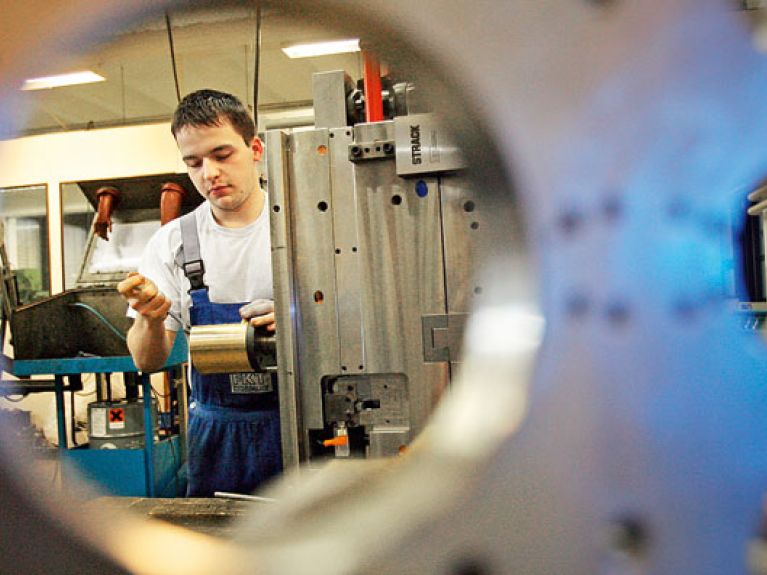Education Made in Germany
Excellent universities, a model vocational system, a dense network of schools abroad – insight into the German education landscape

If you would like to know where Germany can be experienced at its most international, then visit a German university. For example, the Campus Westend of the Goethe University in Frankfurt am Main. For the simple reason that it is still rather new and the bright travertine stone used for the various buildings shines on sunny days, as if the complex was located on the West Coast of America. What is more, Goethe University is celebrating its 100th anniversary in 2014. And above all because, of the twenty German universities attended by large numbers of foreign students, Frankfurt currently has the most: 6,533 of a total of 42,111 students hold a foreign passport. If you go to the restaurant there you will hear a multilingual choir of voices. English, French, Arabic, Chinese – and of course German. Among others. At the counter you will find turkey breast Portuguese-style, chop suey, soya nuggets and Turkish vegetable goulash. Welcome to the global village.
Frankfurt is a prime example of the changes undergone by the German university landscape in recent years. Not just because its old university tower, a 116 meter-high architectural monstrosity, was blown up in spring 2014 in a spectacular controlled demolition, although that was indeed a strong image of a new direction, for which the modern new buildings are just an outward sign. Frankfurt’s motto is, “We want to be Harvard on the Main”. A statement which stands for an ambition shared with other German universities: excellence and internationality, two concepts which are in no way restricted to the large universities or to the eleven universities which gained the seal of an “excellence university” – namely, Aachen, Berlin, Bremen, Dresden, Cologne, Heidelberg, Tübingen, Konstanz and Munich. Internationalisation is a driving force for all German universities. In the winter semester 2013/14, 300,900 foreign students were registered at German universities, corresponding to 11.5%. Germany meantime takes third place on the list of the most popular countries to study in – after the USA and Great Britain. Teaching practice too has become international: almost 90% of the study courses have been adapted to the Bachelor and Master degrees common in most countries. The German Diplom and Magister are now more or less a thing of the past. Of the more than 6,000 Bachelor and 5,000 Master programmes, about a thousand are held in English – and some in French, Italian or Chinese. Numerous structured doctoral programmes and graduates schools are also aimed at bright minds from abroad.
A quick look at the statistics issued by the Conference of University Rectors, what is more, shows that 394 German polytechnics and universities have cooperation projects with international colleges. That means just about all of them, given that Germany has 423 universities in all. This does not just mean one or two projects per university – the University of Freiburg tops the charts with 554 such international cooperation projects, followed closely by the Ludwig-Maximilians-Universität in Munich and the University of Heidelberg. 16 universities have more than 400 partnership projects, another ten have between 300 and 400. And that is just the tip of the education partnerships iceberg – the bare figures. Behind them are to be found countless cases of personal dedication and intercultural exchange, encounters and broadening horizons, the stories of which would fill numerous hard disks.
“Like us, more and more countries are realising that academic excellence can only be achieved through cooperation,” says Professor Joybrato Mukherjee, President of the University of Gießen. The son of Indian immigrants, Mukherjee is also Vice President of the DAAD, the German Academic Exchange Service, which is the world’s largest organisation promoting student and scientific exchange. In 2013 alone, the DAAD enabled sojourns abroad for almost 70,000 German and 50,000 foreign students and researchers. Mukherjee is convinced that the DAAD’s internationalisation and promotion programme have contributed to the fact that today so many international surveys prove the attractiveness of the German university system.
Germany does not regards the internationalisation of education as a “one-way street”: the foreign policy initiative of Foreign Minister Frank-Walter Steinmeier in his first period in office put a whole new emphasis on exchange by means of promoting academic partnerships, so-called German Houses of Science and Excellence Centres abroad – deliberately in regions marked by transformation and conflict. Moreover, numerous German universities are involved in developing German study possibilities and founding universities abroad based on the German model. These are already available in Egypt, China, Jordan, Kazakhstan, Oman, Singapore, Hungary, Vietnam, and, since 2014, in Turkey. What is more, the express objective, supported by numerous programmes, is that by 2020 half of all German students should gain experience abroad. Currently the figure is about 30%.
What the German universities have been increasingly doing for the past decade by “exporting” study course has been the core task of the German Schools abroad since their inauguration: these stand for excellent education “made in Germany”. About 20,000 German and 60,000 non-German pupils attend the 141 German Schools worldwide. At the same time, the School Partnership Initiative PASCH, coordinated by the Foreign Office, is weaving an even denser network of learners of German with the aim of facilitating access to the German language and education for young people abroad (see p. 28).
For German school leavers who are not intending to attend university, the first choice is usually “dual vocational training”, the classic of the German education system. Dual stands for the combination of practical training in a company, for between two and three and a half years, and parallel theoretical training at a vocational school. Dual training such as this based on the German model has also become a successful export item in the field of education, because the format is regarded as a recipe for combatting the youth unemployment that is so widespread in Europe and yet relatively low in Germany. In addition to EU countries, China, India, Russia and countries in Latin America are interested in this training model. All in all, Germany has concluded 40 bilateral cooperation agreements in vocational training. The German embassies, chambers of foreign trade and also German companies in the respective countries are involved in implementing them.
The high standing which the theme of education and science has in Germany is also demonstrated by the fact that the Federal Government is currently investing more than ever before in education and research. The budget for 2014 has risen to more than 14 billion euros – 314 million more than in 2013. “We have become a leading nation in education and research,” says Johanna Wanka, Federal Minister of Education and Research. The governing CDU/CSU and SPD parties decided in their coalition agreement that expenditure on education by the Federation would be increased by a further six billion euros by 2017. The additional funds should relieve the federal states, which have the main responsibility for education in Germany, and enable more money to be invested in schools and universities.
So is everything OK in the German education republic? Surely not. In addition to pride in good systems and success on the path to internationalisation, there are also many challenges: the integration of migrants and educational permeability for children from socially weaker families, more all day schools and the issue of whether 12 or 13 years are sufficient for the school leaving examination, Abitur. There are still a lot of topics to be discussed on matters to do with education. Reason enough for decision-makers in the German education system to broaden their view by considering the solutions which other countries have found for these issues. Which brings us back full circle: exchange ensures enrichment. ▪

